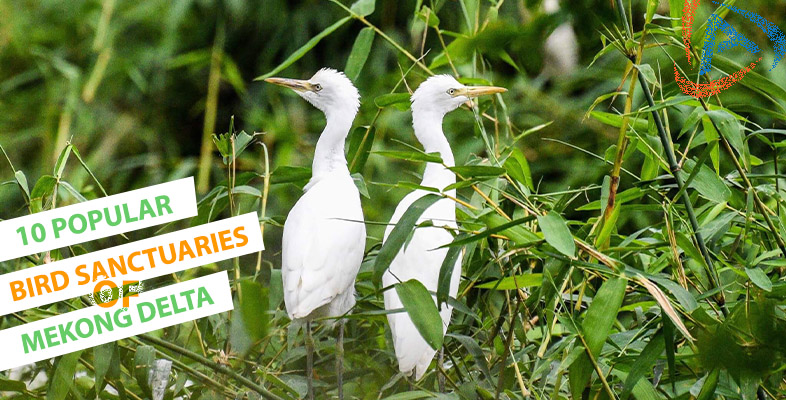
- On 8 August, 2020
- In ALL BLOGS VIỆT NAM BLOGS
- Tags Tags: bird sanctuaries in mekong delta, bird sanctuary, mekong, mekong delta, mekongdelta
10 POPULAR BIRD SANCTUARIES OF MEKONG DELTA
Lying to the west of Hồ Chí Minh City, Mekong Delta stretches all the way to the Gulf of Thailand. Nine rivers flowing from six countries meet here, completing their journey of thousands of kilometers to the sea. For this reason, the Mekong Delta’s Vietnamese name is Đồng Bằng Sông Cửu Long or Nine Dragon river delta.
Visiting to the mighty Mekong River and its delta, one experience out of the many that you can look forward to is bird- watching. World Wildlife Fund has dubbed the Mekong Delta a ‘treasure trove’ of rare creatures teeming with numerous species of plants, lizards, fish, mammals and birds.
The Mekong Delta covers over 40,500 square kilometers of southwestern Việt Nam and serves as its rice bowl. The highly fertile region feeds over 60 million people and is inhabited by approximately 20 million. And although it occupies only 10% of Vietnam’s total land mass, the Mekong Delta provides 60% of its fish and shrimps, and over a third of the country’s food crops.
An expedition through the Mekong Delta will reveal a landscape predominantly dominated by lush floodplains bathed in a variety of green shades. As you move to the north and south, a few hills start to appear.
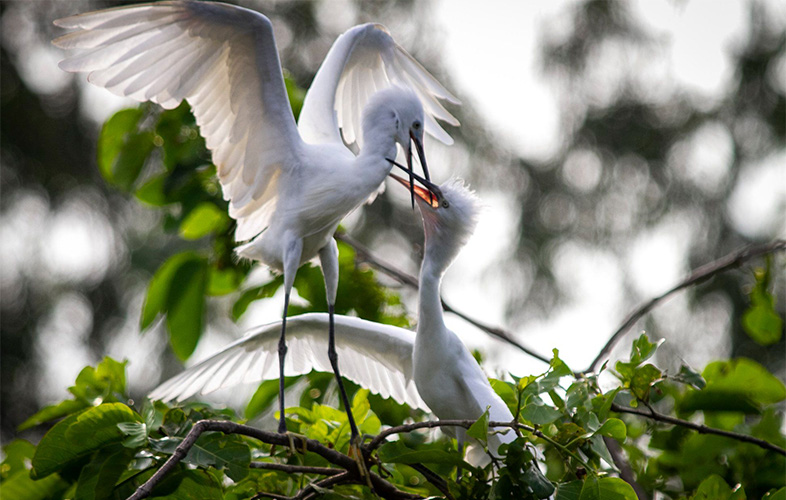
Birdlife in the Mekong Delta
Southern Việt Nam receives 11 inches of rain a month on an average, more than what some regions receive annually. High annual rainfall in South East Asia provides ideal conditions for evergreen forests to flourish. There are two distinct types of evergreen forests: lowland and montane evergreen forests that are home to diverse bird species. In the lowland forests, typical species include cuckoos, bulbuls, flowerpecks, woodpeckers, hornbills and barbets. Upper montane evergreen forests standing at heights of 1,700 meters above sea level are rich in bird species that include flycatchers, babblers, thrushes and warblers. This is also where rare Collared Laughingthrush and Grey-crowned Crocias reside.
The Mekong Delta region is covered with natural grasslands, freshwater wetlands and coastal wetlands. Large parts of the natural grasslands in the Mekong Delta have been converted to agricultural land. Untouched areas continue being home to the Bengal florican, the only member of the genus Houbaropsis and a Critically Endangered species on the IUCN Red List. The grasslands that remain get flooded seasonally and are frequented by sarus cranes, the tallest flying birds in the world, during the winter. The Mekong Delta’s native mangrove forests are inhabited by the Oriental Darter and many other endangered species.
Since 1988, a total of 247 bird species has been recorded here, with an estimated 50% of the species dependent on wetlands, of which 20 are listed as globally threatened or near threatened. Over the years, several artificial lakes and reservoirs have been created to help protect endangered species against extinction and maintain healthy avifauna diversity.
10 Popular Bird Sanctuaries of Mekong Delta
These are some of the best bird sanctuaries of Mekong Delta which one must visit to witness the beauty of the varied species of birds that migrate from corners of the world.
- Vàm Hồ Bird Sanctuary, Bến Tre Province
- Bạc Liêu Bird Sanctuary, Bạc Liêu Province
- Tràm Chim National Park, Đồng Tháp Province
- Gáo Giồng Eco-tourism Park, Đồng Tháp Province
- Trà Sư Bird Sanctuary, An Giang Province
- Bằng Lăng Stork Sanctuary, Cần Thơ City
- U Minh Thượng National Park, Kiên Giang Province
- Lâm Viên Bird Garden, Cà Mau Province
- Tư Na Bird Garden, Cà Mau Province
- Ngọc Hiển Bird Garden, Cà Mau Province
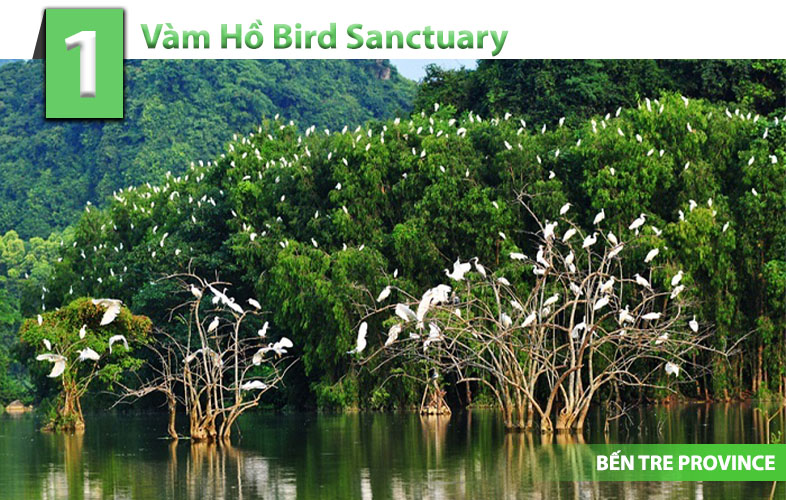
Vàm Hồ Bird Sanctuary is located between Mỹ Hòa commune and Tân Xuân commune, Ba Tri district of Bến Tre province, near the Ba Lai River. It is about 52 km from Bến Tre city, about 120 km from Hồ Chí Minh City. From Ho Chi Minh City, you can get there by bus or boat. It would be better if you use the boat because you will have chance to travel along Mekong Delta.
Vàm Hồ Park is a unique ecosystem with typical coastal mangrove forests in the Mekong River Delta, with a high biological value and potential to develop and contribute ecotourism in Việt Nam. Vàm Hồ covers many wild forests with a great variety of trees including water coconut, mangrove, and reed, etc. Vàm Hồ has become a favorite habitat for many animals, especially birds. There are about 84 species of birds, including 500,000 storks. Vàm Hồ Bird Sanctuary is home of thousands of storks, herons, flamingos and many other kinds of birds.
The best time to see the storks is from April to October of lunar calendar when birds migrate and reproduce there. When sun is set at 4pm to 5pm, thousands of birds from surrounding areas fly to Vàm Hồ and sleep there. Then, an interesting event takes place. Thousands of storks whiten almost the tree tops. Meanwhile, the herons begin their night searching for food. Tourists may find themselves get lost in the world of birds, with various shapes and sounds. The sound of thousands of birds mixing and playing, dancing and whooping becomes the enchanting song of the jungle. In addition, the song of the storks has different rhythms and calls of other wild birds mixed with the sound of leaves, which makes a silent summer’s night shimmer with excitement. Besides birds, visitors can see many bats, snakes, weasels and pythons there.
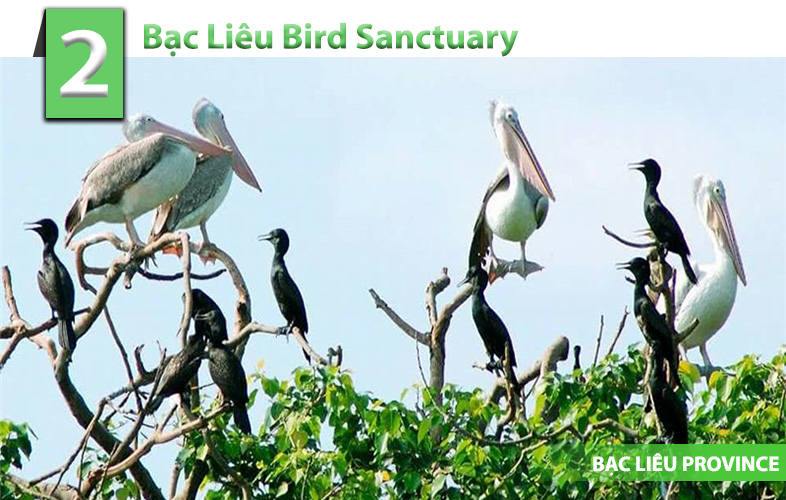
Bạc Liêu Bird Sanctuary is located on the territory of Nhà Mát ward, Bạc Liêu town, about 6 kilometers from the east of town and from the north of Bạc Liêu Sea. This is a conversation area where lots of birds come here to reside and give birth. It covers some 107 hectares and lies within the remaining 385 hectares of forest area. The sanctuary is now home to 46 bird species consisting of rare and precious species: Giang Sen, Dien Dien, Co Ruoi, etc, 60 fish species, seven frog species, 10 species of mammals, eight reptile species, and 100 species of plants. On the ground are a massive number of eggs, and in the air, you can spot some species with 2 meters wing-spans.
Over nearly one century, the Sanctuary is the place where generations of birds are born, usually in the rainy season, and developed. There are currently some 40,000 birds and 5,000 nests, according to preliminary statistics. Birds mostly gather here during the rainy season between May and October. In August and September, flocks of birds gather at the sanctuary to build nests and breed. The forest comes alive with the singing of various kinds of birds and trees overflow with hundreds of birds’ nests. The Sanctuary is also the important home of several water birds, mainly teal, stork, heron, night heron and cormorant.
The best time to visit Bạc Liêu Bird Sanctuary is in the early morning when most birds leave their nests to begin a day of feeding. Alternatively, at sunset the birds can also be seen more easily as they return to their nests to sleep, flocks of bird fly one after another. This is the moment of enjoying the most spectacular sight the sanctuary.
Moreover, the rich flora and fauna of the enclosure gives the lush, natural area a feeling of wonder and enchantment. Bạc Liêu Bird Sanctuary is a favorite destination of both nature lovers and researchers and visitors will easily find several types of birds listed in Việt Nam’s “Red Book” of endangered species of plants and animals. The area is also popular amongst photographers who come to the sanctuary for one-of-a-kind shots of the breathtakingly beautiful birds.
Currently, Bạc Liêu Bird Sanctuary is one of the areas listed into wetland in Asia and also be the national natural conservation playing an important role in Việt Nam as well as the world. Bạc Liêu Bird Sanctuary is the great choice for the youth who would like to camp and travel after stress days for studying. The sanctuary not only attracts young people but also the elderly by its potential.
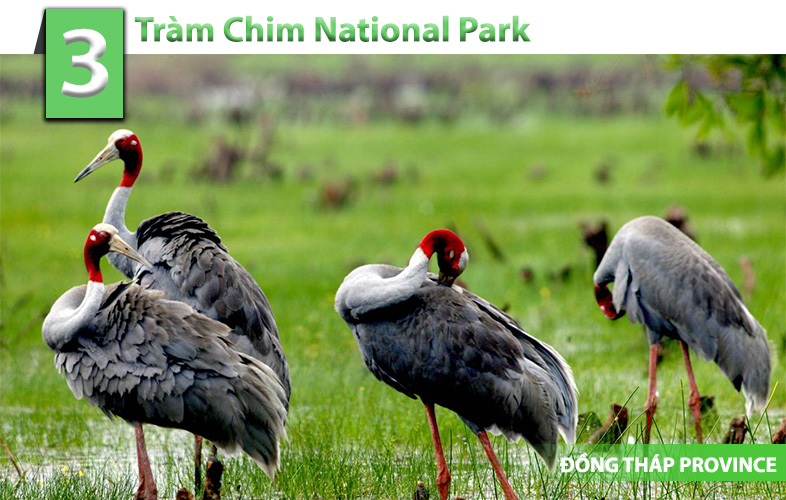
Located in Đồng Tháp Province’s Tam Nông District, the park is the fourth Ramsar site in Việt Nam and the 2,000th worldwide. It has a special-use forest with distinctive wetland ecosystems spanning more than 7,300 hectares. Visitors can spot over 231 species of aquatic birds, including 16 rare breeds such as the Burmese Sarus crane, greater adjutant, black-headed ibis, black-faced spoonbill, and great-billed heron.
The stunning landscape of Tràm Chim National Park is at its most attractive during the “floating water season”, or flooding season, from September to December. Taking advantage of the flooding season, tourism authority in the province offers tourists a chance to work like regular fishermen, and enjoy local food and beverages.
Tràm Chim National Park has lots of interesting scenery, which creates a good chance for tourists to do some sightseeing while sitting on beautiful boats. In a tranquil atmosphere, visitors can admire the elegance of colorful lotus petals and smell the freshening aroma of them. This may create a memorable experience in every visitor’s life.
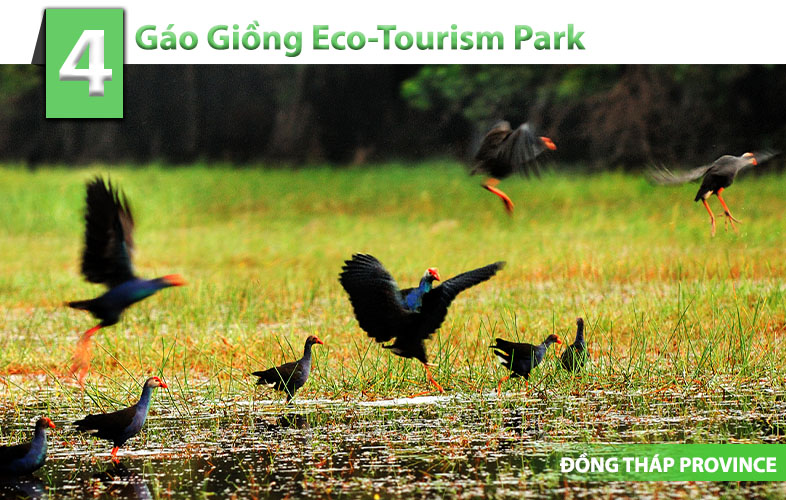
Lying within the flooded Đồng Tháp Mười area in Cao Lãnh District, Đồng Tháp Province, Gáo Giồng Eco-Tourism Park has become a popular destination for both domestic and foreign tourists to relax and enjoy meandering sampan cruises through the wetlands. The environment is an example of the region’s mangrove lowlands and the park acts as a ‘green lung’ of the Đồng Tháp Mười region.
The way to the park is lined by green rice fields dotted with houses and small gardens and alluvial canals. The scenery embraces stillness and a deserted atmosphere. Before stepping into the Gáo Giồng bird yard, tourists will be taken to an 18-meter-high tower to catch a
panorama of the bird yard and the endless cajuput forest.
The bird sanctuary covers 35 hectares with diversified species including egrets, sparrows, wild ducks and herons, and, especially some rare species listed in the Red Book.
Tourists are enthralled by the sounds of the birds swinging on cajuput trees or perched on lotus flowers. At dawn and at sunset especially, the melodies are a nice background to the inherent stillness.
Drifting on canals shaded by cajuput trees, contemplating the hundreds of birds singing happy songs and getting lost in the poetic and deserted space, excursionists take home unforgettable memories of the Mekong Delta.
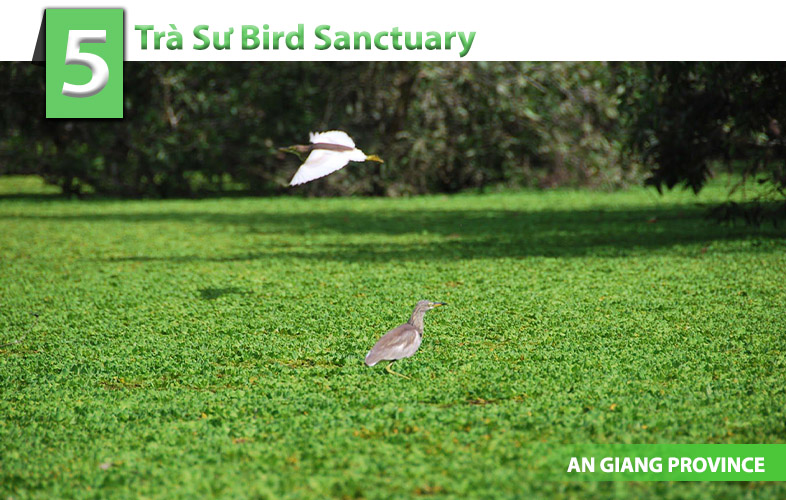
Việt Nam’s magical 1500-hectare Trà Sư Bird Sanctuary, with its core 850 hectares of mainly cajuput (melaleuca) forest, is a gem in a country that crams 94 million people into a skinny dragon-shaped area less than half the size of NSW.
Trà Sư is home to 140 types of flora, 70 species of birds, 11 types of animals, 25 species of reptiles, and 23 kinds of fish. Add to that the environmental pressures of deforestation, overfishing and water pollution, and the existence of a unique area where nature dominates is even more remarkable.
During the high water season, the forest’s canals and streams are dense with clusters of water ferns, a particularly vivid sight when the setting sun imparts a golden glow on the emerald-green duckweed that blankets the water’s surface. Lotus flowers and water lilies, cultivated by local farmers to supplement their incomes during the rainy season, cover much of the water. However, as night settles and the sun sets, the view changes and becomes enlivened as the birds return home for the night, covering the night sky in a huge screeching mass of feathers.
The best time to visit Trà Sư is at the high water season, from September to November. At this time of the year, the entire forest floats on a vast area, so a motor-boat is the only way to travel around. Indeed, rowing along the green mysterious canals is a particularly good idea, since the tourists are able to stop as they chose to pick wild berries or fruits or go for a bit of fishing in quiet contemplation.
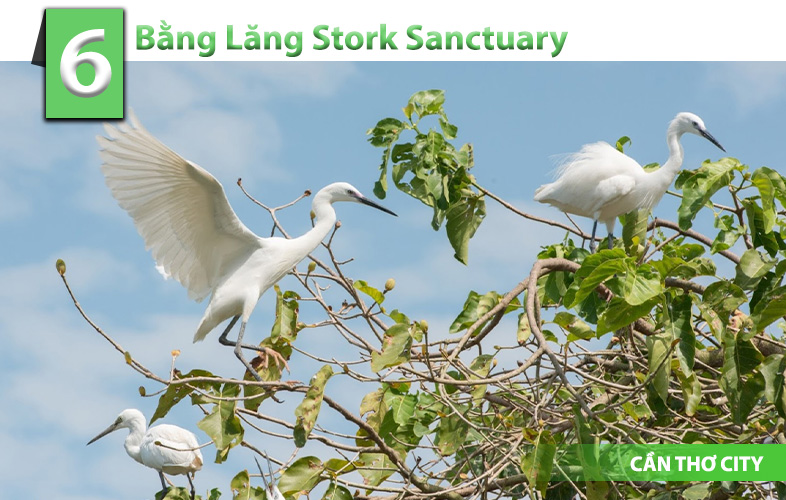
On the road between Cần Thơ and Long Xuyên, this magnificent 1.3-hectare bird sanctuary has astonishing views of thousands of resident storks and snowy egrets. There is a tall viewing platform to see the birds filling the branches. The best times to view this incredible sight are around dawn and dusk.
There are various species of storks living at Bang Lang Stork Garden including cattle egret, ibis, striated heron and painted stork. There are also other species making it their home such as black-crowned night heron, little cormorant and greater causal heron.
The garden was spontaneously established in 1983. It is strange that a large number of storks chose to make their home at the garden of Mr. Bay Co. At first, there were very few but then Mr. Bay has created good conditions for the storks to live in his garden. Since then, Bang Lang garden has gradually been expanded with the current area of about 2 hectares and number of storks ranging from 100,000-150,000 of more than 20 species.
The best time to admire the garden is 5 p.m. when flocks of storks fly back to their nests. They hover on the sky then perch on tree peaks, twitter together and pose in the wind. You must not forget to take photos of those moments. There is a three-meter watching tower for tourists to see birds. Wearing a hat might help as the site is smothered with their droppings.
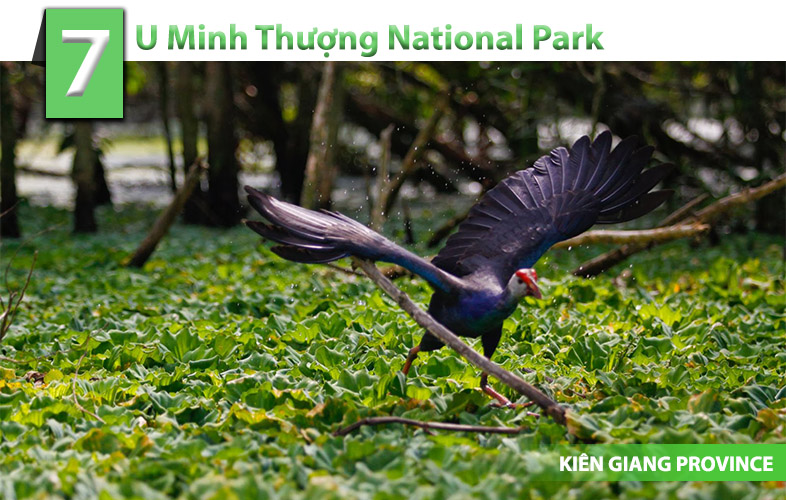
Located in An Minh and Vĩnh Thuận districts, Kiên Giang Province and about 365km south-west of Hồ Chí Minh City, U Minh Thượng National Park is recognized as one of the three highest priority sites for wetland conservation in the Mekong Delta.
One salient characteristic that will strongly impress you is that U Minh Thượng National Park is situated in an area of freshwater wetlands, comprising peat swamp forest, seasonally inundated grassland. The core zone of U Minh Thượng National Park is surrounded by a perimeter canal and dyke system, with a series of gates, which are used to manage the water level.
Surveys to date have confirmed the presence of 187 bird species at U Minh Thượng National Park, including 9 species of global conservation concern such as: oriental darter, spot-billed pelican, painted stork, lesser adjutant, black-headed ibis, glossy ibis, greater spotted eagle, grey-headed fish eagle and Asian golden weaver. In addition, at least eight species of economically valuable fish are found at this park.
This park harbors a diversity of flora with 226 species of non-cultivated vascular plants which are very rare in South-East Asia. The natural vegetation was classified into 10 types, belonging to four main classes: Melaleuca forests, seasonally inundated grasslands, permanent swamps and vegetation along canals and streams. Visitors can pay a visit to this destination all year round. However, it is highly recommended to avoid March and April as this is the dry season in this region when there are not so many activities available and people focus on prevent the fire as well as control for the forest.

Although being firstly built in 1995, the garden officially came to light in 1997. Currently managed by the provincial Department of Culture and Information, the area of the park spans about 18 hectares, in which the area of bird gardens is about 8 hectares. Believe it or not, Lâm Viên can welcome up to 10,000 birds every spring.
Situated just about 2 km from Cà Mau city, the bird garden attracts a number of visitors day to day, because this is a great chance for them to spread their own eyes over many species of birds, such as cauldron, nipples, storks, gongs, water chickens, etc. Their activities (i.e. dancing, cuddling, singing, etc.) are in harmony, creating the impressive symphony till the sunset. Among them, crane is known as the most impressive and precious bird in the garden campus. However, you still find a lot of rare bird species here, like ancient pelican, dandelion, heron, and oat and so on.
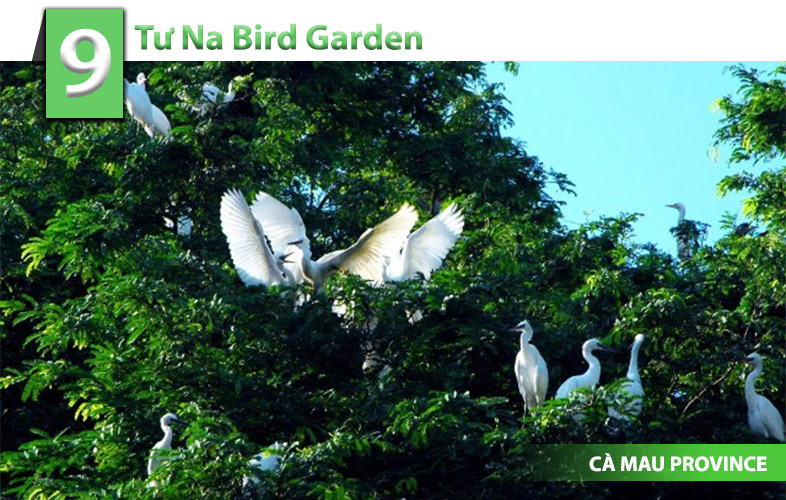
Tư Na bird garden in Cà Mau province is another popular destination for bird lovers, especially during the flood season. It is currently home to approximately 100,000 birds of 74 bird species, in which most of them are the rare species in the list of Red Data Book of Vietnam and over the world, such as Giang Sen, Chang be, quam, and so on. That’s why the garden is said to be abundant in both quality and quantity.
The most outstanding creature here is the white stork that may be often be seen flying above the garden or simply perching on green trees. Deeply in the lush mangrove forest with small lights, visitors can even see bird nests on the tree by chance. Birds diving in the water to catch fish and shrimp create a lively and meaningful vista.
Of course, the more you explore the Tu Na bird garden, the more harmonious sound of thousand bird species you will enjoy. All certainly makes your mind and body truly joyful, peaceful, and comfortable.
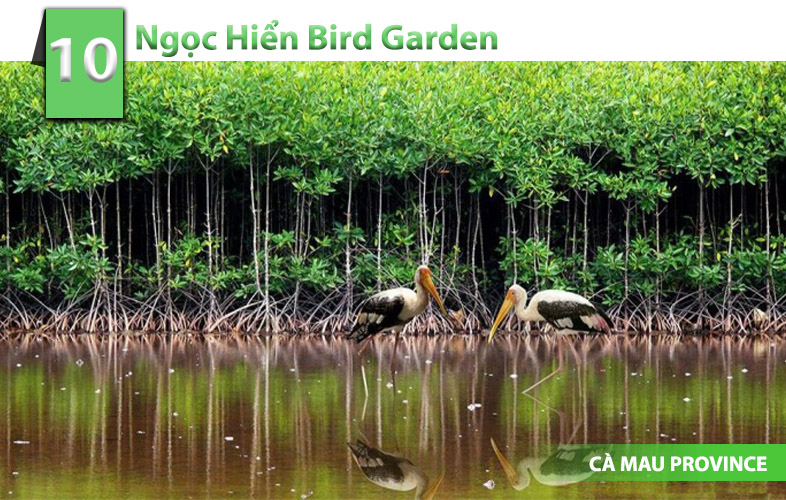
As one of the largest natural bird sanctuaries in Việt Nam with area of more than 130 hectares, Ngọc Hiền Bird Garden is surrounded by a network of interlacing canals. The airy and pleasant year-round natural environment here creates a favorable habitat for thousands of bird species and storks.
The charm of this garden is seen not only in the diversity of bird species, but also in the flawless harmony of the smoothing river and green forests. The awe-inspiring Bay Hap instantly wins your heart by its elegant beauty. You are recommended to visit the sanctuary in the morning or in the early evening when flock of birds search for food or get back to their warm nests.
In comparison to the above 2 bird gardens, Ngọc Hiền cannot be the one that you are dying to go, but it is worth visiting if you want to put your mind at ease. The pristine wilderness and fresh ambiance become your inspiration for poems or even songs. Furthermore, the birds here are seemly familiar with human observation. Photographers can feel regretful if they miss an opportunity to have great photo collection while in here.